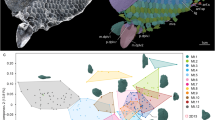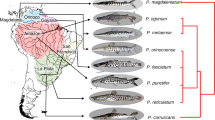Abstract
ACCORDING to current accounts of scale formation in Teleosts, the scale papillæ originate as independent centres of growth, their constituent cells being derived from the immediately underlying dermis. The remarkable regularity of arrangement of the scales in most fishes has always attracted attention and has led Backman1 to suggest that each papilla exercises an inhibiting influence on the development of the immediately surrounding tissue.
This is a preview of subscription content, access via your institution
Access options
Subscribe to this journal
Receive 51 print issues and online access
$199.00 per year
only $3.90 per issue
Buy this article
- Purchase on Springer Link
- Instant access to full article PDF
Prices may be subject to local taxes which are calculated during checkout
Similar content being viewed by others
References
Verh. anat. Ges. Jena, 41.
Author information
Authors and Affiliations
Rights and permissions
About this article
Cite this article
NEAVE, F. Origin of the Teleost Scale-Pattern and the Development of the Teleost Scale. Nature 137, 1034–1035 (1936). https://doi.org/10.1038/1371034b0
Issue Date:
DOI: https://doi.org/10.1038/1371034b0
This article is cited by
-
Fine structure of the developing frontal bones and scales of the cranial vault in the cichlid fish Hemichromis bimaculatus (Teleostei, Perciformes)
Cell & Tissue Research (1993)
-
Collagen formation and calcification in teleost scales
Zeitschrift f�r Zellforschung und Mikroskopische Anatomie (1968)
Comments
By submitting a comment you agree to abide by our Terms and Community Guidelines. If you find something abusive or that does not comply with our terms or guidelines please flag it as inappropriate.



